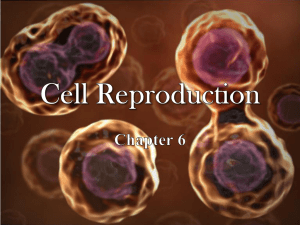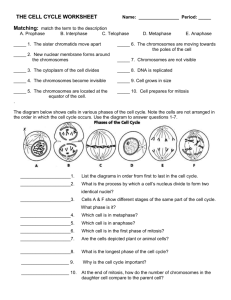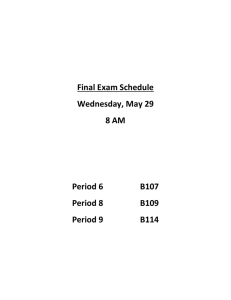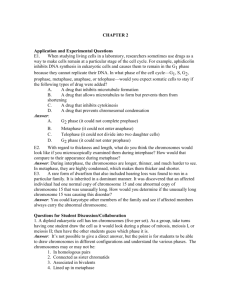Name:____________________________ BIOL. 1406. Fall Semester, 2004 FINAL EXAM (COMPREHENSIVE)
advertisement
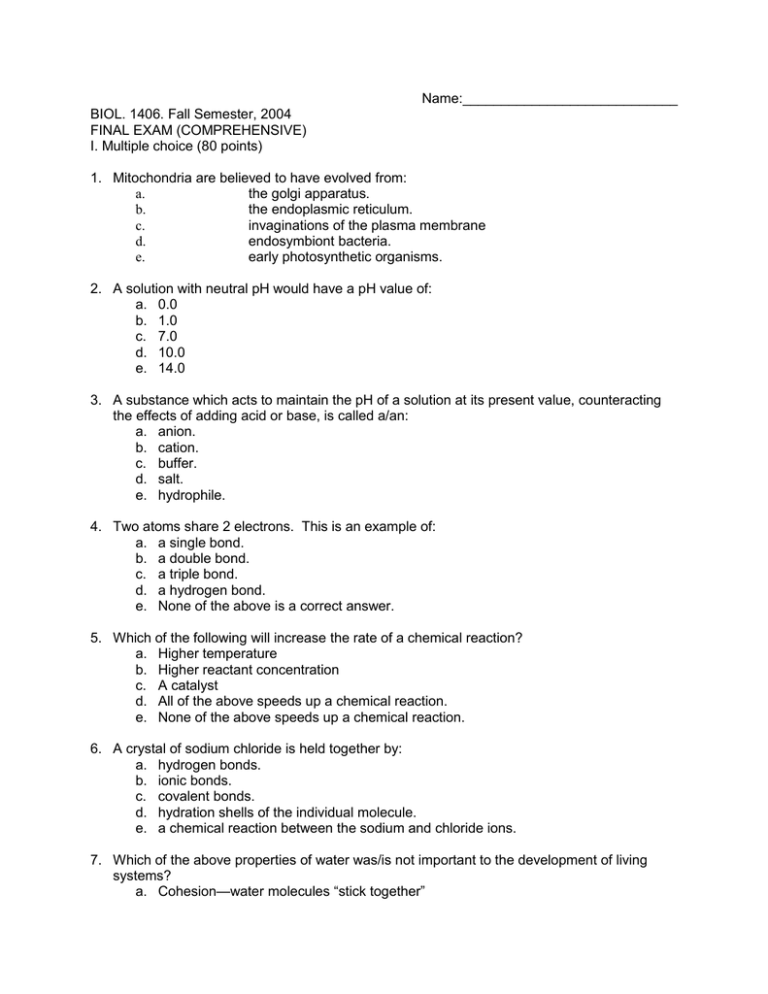
Name:____________________________ BIOL. 1406. Fall Semester, 2004 FINAL EXAM (COMPREHENSIVE) I. Multiple choice (80 points) 1. Mitochondria are believed to have evolved from: a. the golgi apparatus. b. the endoplasmic reticulum. c. invaginations of the plasma membrane d. endosymbiont bacteria. e. early photosynthetic organisms. 2. A solution with neutral pH would have a pH value of: a. 0.0 b. 1.0 c. 7.0 d. 10.0 e. 14.0 3. A substance which acts to maintain the pH of a solution at its present value, counteracting the effects of adding acid or base, is called a/an: a. anion. b. cation. c. buffer. d. salt. e. hydrophile. 4. Two atoms share 2 electrons. This is an example of: a. a single bond. b. a double bond. c. a triple bond. d. a hydrogen bond. e. None of the above is a correct answer. 5. Which of the following will increase the rate of a chemical reaction? a. Higher temperature b. Higher reactant concentration c. A catalyst d. All of the above speeds up a chemical reaction. e. None of the above speeds up a chemical reaction. 6. A crystal of sodium chloride is held together by: a. hydrogen bonds. b. ionic bonds. c. covalent bonds. d. hydration shells of the individual molecule. e. a chemical reaction between the sodium and chloride ions. 7. Which of the above properties of water was/is not important to the development of living systems? a. Cohesion—water molecules “stick together” b. c. d. e. High specific heat--water requires much energy to raise its temperature High heat of vaporization--much energy absorbed when water evaporates Low density of ice—it floats All of the above are properties of water that are important to the development and maintenance of life on this planet. 8. The type of reaction commonly used to disconnect (break apart) the monomeric units of macromolecules is best classified as a/an: a. exergonic reaction. b. hydrolysis reaction. c. disulfide reaction. d. hydrogen bonding. e. dehydration reaction. 9. The actual sequence of amino acids in a polypeptide/protein is called its: a. primary structure. b. secondary structure. c. tertiary structure. d. quaternary structure. e. None of the above are correct answers. 10. An example of a type of chemical bond which involves a full separation of charge (transfer of electrons) is a/an: a. hydrogen bond. b. ionic bond. c. covalent bond. d. hydrophobic bond. e. electron bond. The four most common elements in living systems are: a. carbon, hydrogen, oxygen and phosphorous. b. carbon, hydrogen, nitrogen and oxygen. c. carbon, oxygen, nitrogen and phosphorous. d. carbon, oxygen, nitrogen and iron. e. carbon, oxygen, nitrogen and calcium. 11. The beta-sheet and alpha-helix of a folded protein/polypeptide would be examples of its: a. primary structure. b. secondary structure. c. tertiary structure. d. quaternary structure. e. All of the above are correct answers. 13. Proteins which act as catalysts of chemical reactions [in cells] are called: a. enzymes. b. coenzymes. c. reaction cofactors. d. substrates. e. reactants 14. A chemical reaction that releases energy is known as a(an) __________ reaction. a. exergonic. b. coupled. c. anabolic. d. endergonic. e. unfavored 15. The second law of thermodynamics states that for chemical reactions: a. entropy always increases. b. entropy always decreases. c. free energy always increases. d. free energy always decreases. e. anabolic reactions must always be paired with catabolic reactions. 16. The electron transport chain utilized to make ATP during photosynthesis by plants is located in the: a. stroma. b. thylakoid membrane. c. inner chloroplast membrane. d. outer chloroplast membrane. e. plasma membrane. 17. In the process of _______________ reactions, energy usually gets released. a. endergonic b. hypergonic c. exoteric d. exergonic e. endotermic 18. Energy stored in ATP is located exactly: a. in the bonds between phosphate groups b. inside the phosphate group c. in the free electron d. attached to the nucleotide e. between the sugar and the phosphate 19. NAD+ and NADP+ are examples of: a. electron carriers. b. oxidizing compounds. c. photosynthetic pigments. d. sugar-storage molecules. e. competitive inhibitors. .20. The 5 carbon sugar that captures (fixes) carbon dioxide in C3 plants as the first step in the Calvin cycle is: a. PEP carboxylase. b. glucose kinase. c. pyruvate synthetase d. CAM synthetase e.RuBP 21. Where does the O2 released during photosynthesis come from? a. CO2 b. H2O c. ATP d. C6H12O6 e. RuBP 22.The products of photosynthesis are a. glucose and water. C b. carbon dioxide, water, and energy. c. glucose and carbon dioxide. d. carbon dioxide, chlorophyll, and oxygen. e. glucose and oxygen. 23. The net yield of ATP from a glucose molecule being metabolized through glycolysis to pyruvate is ______ molecule(s). a. 1 b. 2 c. 4 d. 36 e. 42 24. In which phase of meiosis do the homologous chromosomes undergo separation? a. metaphase I b. anaphase II c. prophase I d. metaphase II e. anaphase I 25. During which phase of meiosis are the tetrads of homologous chromosomes aligned at the center of the dividing cell? a. prophase I b. metaphase I c. anaphase II d. anaphase I e. metaphase II 26. During which phase of meiosis do the centromeres uncouple and sister chromatids separate? a. anaphase I b. prophase II c. metaphase II d. anaphase II e. metaphase I 27.A human gamete has: a. 23 chromosomes. b. 46 chromosomes (23 pairs). c. 46 chromosomes. d. 23 autosomes. e. two sex chromosomes. 28.The two sister chromatids of a eukaryotic chromosome are connected at the: a. centromere. b. c. d. e. centriole. chiasma. telomere. centrosome. 29.The intertwining (crossing over) of paternal and maternal homologous chromosomes during meiosis is called: a. partitioning. b. anaphase c. chiasma. d. pleiotropy. e. epistasis. 30.The electrons from NADH, when fed through the electron transport chain of mitochondria, provide a theoretical yield of: a. 1 ATP. b. 2 ATP. c. 3 ATP. d. 4 ATP. e. 1 oxygen. 31.Snapdragons have a sincle gene (locus) that determines flower color. The allele R is for red flowers and it shows incomplete dominance over the recessive allele r for white flowers. What color flowers are produced by Rr plants? a. All red b. Mixed red and white (some flowers of each color) c. pink d. white with pink streaks e. purple 32.Genes located on the same chromosome are said to be: a. polygenic. b. bottlenecked. c. pleiotropic. d. linked. e. epistatic. 33.An inactivated ‘X’ chromosome in a human female cell is seen as a/an: a. centrosome. b. Barr body. c. genetic imprint. d. nucleosome. e. centromere. 34.A human with the XXY karotype is: a. phenotypically a male and no Barr body. b. phenotypically female. c. phenotypically male but with a Barr body. d. phenotypically female with no Barr body. e. frequency-dependent selection. 35.A person with a karyotype of trisomy 21 will suffer from: a. Tay-Sachs. b. Down Syndrome. c. Kleinfelter Disease. d. Huntington Disease. e. Turner Syndrome. 36. DNA of a certain organism has guanine as 30% of its bases. What percentage of its bases would be adenine? A) 0% B) 10% C) 20% D) 30% E) 40% 37.Which of these is found in RNA but NOT in DNA? a. adenine b. uracil c. thymine d. phosphate groups e. none of theabove 38.The process of copying genetic information from DNA to RNA is called a. translation. b. transformation. c. replication. d. transcription. e. polymerization. 39.A random change in a DNA nucleotide base sequence a. has no influence on genetic variation. b. is never expressed phenotypically. c. constitutes a mutation. d. is never beneficial to the organism. e. will kill the cell when it occurs. 40.RNA splicing is the a. addition of introns to the mRNA. b. deletion of introns from the mRNA. c. addition of exons to the mRNA. d. deletion of exons from the mRNA. e. combination of two different chromosomes together 41.Evidence which supports the theory of evolution is found in the studies of a. comparative anatomy and embryology. b. genetics and molecular biology c. fossils. d. artificial selection. e. all of these 42.Boa constrictors have tiny pelvic girdles and leg bones within their bodies. Since these structures are nonfunctional, they are called a. extra. b. analogous. c. maladaptive. d. homologous. e. vestigial. 43.Founder populations may quickly become very different from the parent population in a similar habitat due to a. natural selection. b. artificial selection. c. bottleneck. d. genetic drift. e. mutation. 44.A population with ________ is at risk for extinction. a. large size b. low genetic variation c. too little gene flow d. low levels of genetic drift e. random mating 45.Mutations a. b. c. d. e. are random. occur to solve problems for species (are goal oriented). can alone cause drastic changes in the gene frequencies of a population. Only choices A and B are correct. are always detrimental. 46.Giraffe leg and neck length increased under ________ selection, but currently is probably maintained by ________ selection. a. directional; disruptive b. directional; stabilizing c. disruptive; stabilizing d. stabilizing; disruptive e. disruptive; directional 47) Two populations of mountain dwelling salamanders are separated by an impassable valley. The populations are ________. A) allopatric B) sympatric C) divergent D) founders E) subspecies 48) When a species invades a new habitat and evolves rapidly into several new species to better exploit new resources (e.g., Darwin's Finches), what has occurred? A) phyletic speciation B) divergent speciation C) stabilizing selection D) polyploidy E) adaptive radiation 49) Two different species of pine release their pollen at different times. This is an example of A) geographical isolation. B) ecological isolation. C) behavioral incompatibility. D) temporal isolation. E) mechanical isolation. 50) Two species of garter snakes live in the same geographic area. One mainly lives in water and the other mainly on land so that they rarely encounter each other and do not interbreed. This is an example of what type of genetic isolation? A) ecological B) temporal C) mechanical D) behavioral E) directional 51) In many species of fireflies males flash to attract females. Each species has a different flashing pattern. This is an example of A) allopatric speciation. B) geographical isolation. C) temporal isolation. D) natural selection. E) behavioral isolation. 52) The great dane and the chihuahua are both domestic dogs (the same species), but mating between them is limited by A) hybrid infertility. B) hybrid inviability. C) mechanical incompatibility. D) behavioral isolation. E) heterozygote disadvantage. 53) Donkeys and horses can interbreed and produce offspring called mules that live normal life spans but are sterile. Horses and donkeys remain isolated genetically because of A) hybrid infertility. B) hybrid inviability. C) mechanical incompatibility. D) behavioral isolation. E) heterozygote disadvantage. 54) The greatest cause of extinctions is A) asteroid impacts. B) interactions with other species. C) overspecialization. D) habitat change. E) limited species range.



